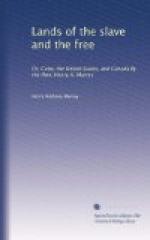I was rather amused by a story I heard, of a newly-arrived Paddy emigrant, who, having got a little money, of course wanted a little whisky. On going to the bar to ask the price, he was told three-halfpence. “For how much?” quoth Paddy. The bottle was handed to him, and he was told to take as much as he liked. Paddy’s joy knew no bounds at this liberality, and, unable to contain his ecstasy, he rushed to the door to communicate the good news to his companions, which he did in the following racy sentence: “Mike! Mike, my sowl! com’ an’ haf a dhrink—only thruppence for both of us, an’ the botthel in yer own fisht!”
One unfortunate fellow on board had lost a letter of recommendation, and was in great distress in consequence. I hope he succeeded in replacing it better than a servant-girl is said to have done, under similar circumstances, who—as the old story goes—having applied to the captain of the vessel, received the following doubtful recommendation at the hand of that functionary: “This is to certify that Kate Flannagan had a good character when she embarked at New York, but she lost it on board the steamer coming up. Jeremiah Peascod, Captain.”
The scenery of the Hudson has been so well described, and so justly eulogized, that I need say little on that score. In short, no words can convey an adequate impression of the gorgeousness of the forest tints in North America during the autumn. The foliage is inconceivably beautiful and varied, from the broad and brightly dark purple leaf of the maple, to the delicate and pale sere leaf of the poplar, all blending harmoniously with the deep green of their brethren in whom the vital sap still flows in full vigour. I have heard people compare the Hudson and the Rhine. I cannot conceive two streams more totally dissimilar—the distinctive features of one being wild forest scenery, glowing with ever-changing hues, and suggestive of a new world; and those of the other, the wild and craggy cliff capped with beetling fortresses, and banks fringed with picturesque villages and towns, all telling of feudal times and an old world. I should as soon think of comparing the castle of Heidelberg, on its lofty hill with Buckingham Palace, in its metropolitan hole.—But to return to the Hudson.
In various places you will see tramways from the top of the banks down to the water; these are for the purpose of shooting down the ice, from the lakes and ponds above, to supply the New York market. The ice-houses are made on a slope, and fronting as much north as possible. They are built of wood, and doubled, the space between which—about a foot and a half—is filled with bark, tanned. In a bend of the river, I saw the indications of something like the forming of a dock, or basin; and, on inquiry, was told it was the work of a Company who imagined they had discovered where the famous pirate Kidd had buried his treasure. The Company found to their cost, that it was they who were burying their treasure, instead of Captain Kidd who had buried his; so, having realized their mare’s-nest, they gave it up. One of the most beautiful “bits” on the Hudson is West Point; but, as I purpose visiting it at my leisure hereafter, I pass it by at present without further comment.




